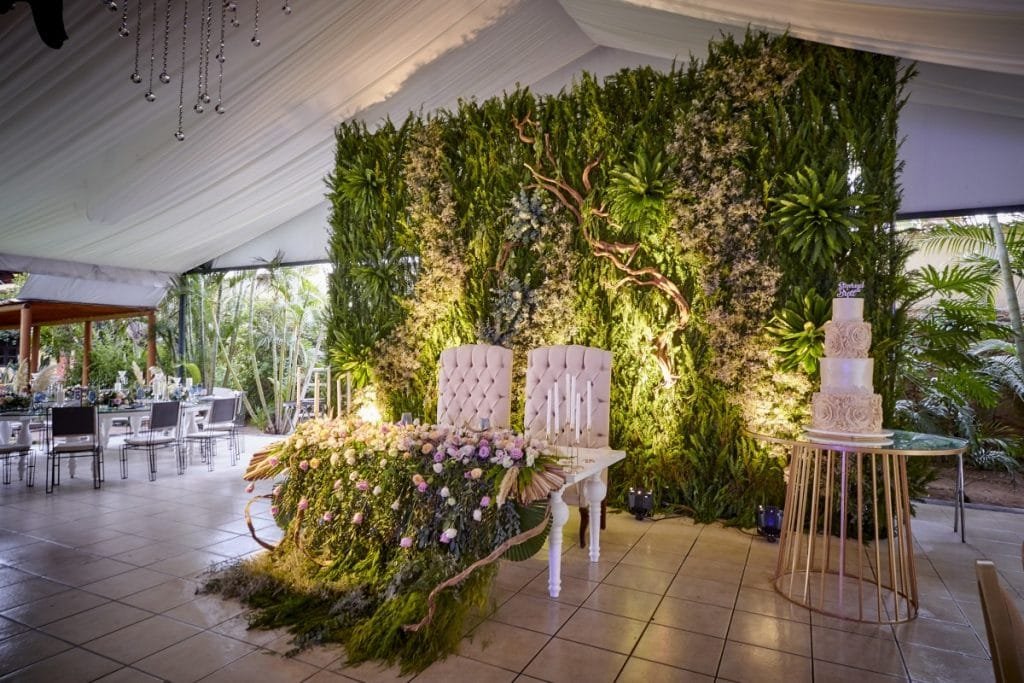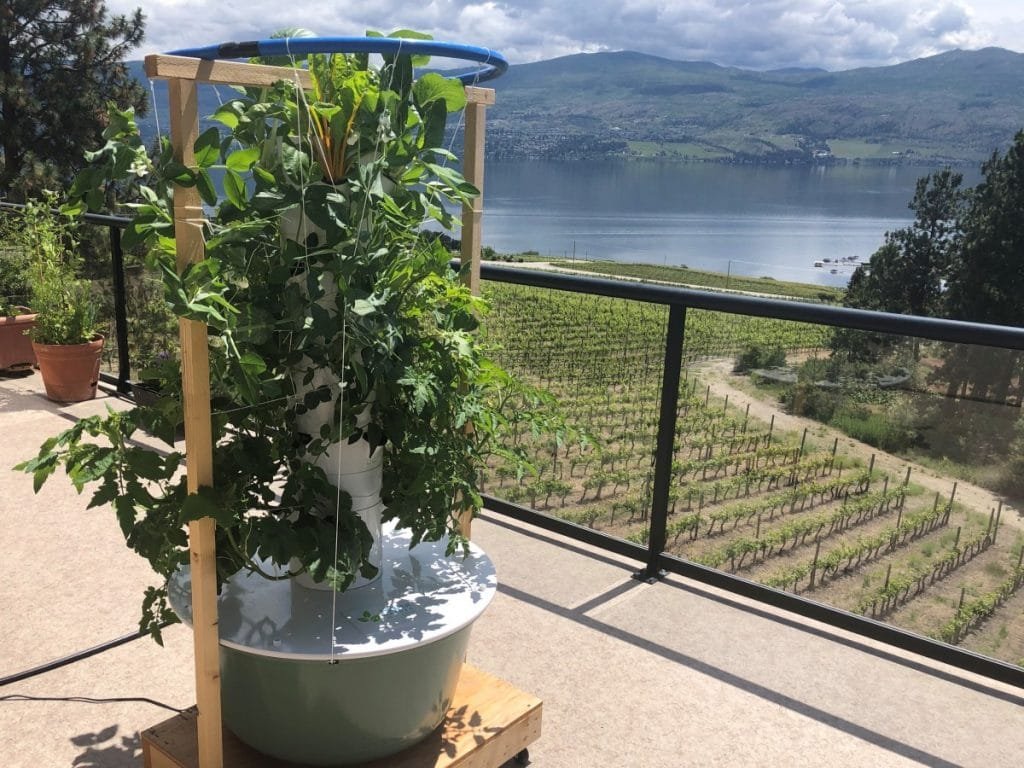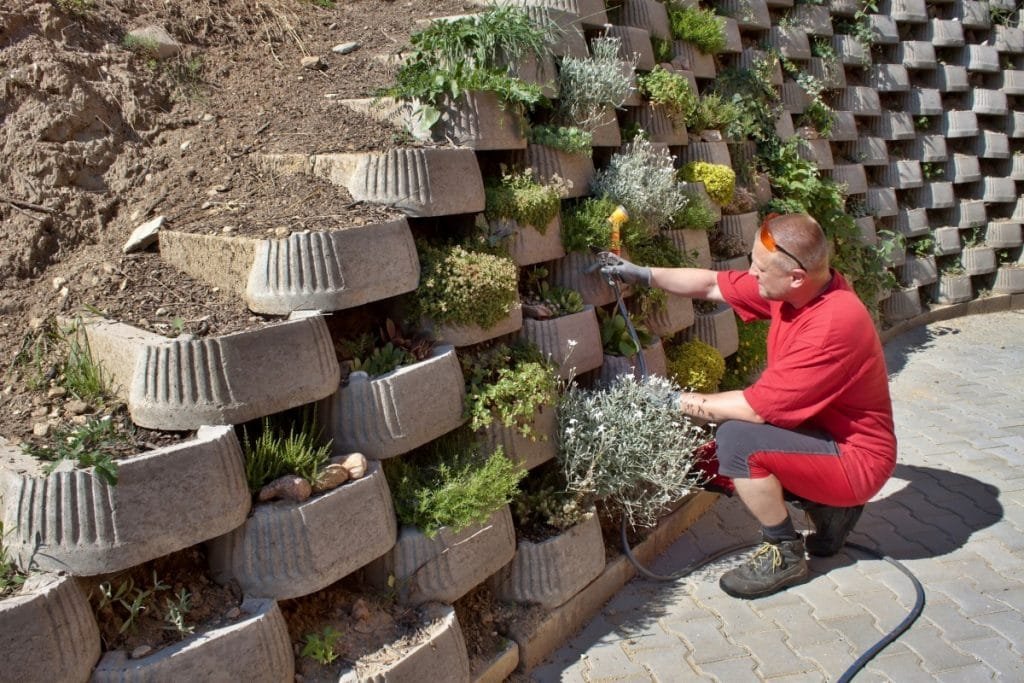Living walls are an incredibly appealing feature to have in your home or office, but unfortunately, they do not last forever! Many factors influence how long an interior or exterior living wall will last, but most important is your choice of plants and how you maintain them.
The structure and hardware that living walls are made from are robust and can last for up to 25 years, but the plants themselves will generally not survive this long. Depending on the type of living wall system, the plants will last for 4 to 6 years, possibly 10 years, with good maintenance.
One of the biggest drawbacks to living walls is how much maintenance they require. Besides watering and feeding the plants, you also have to remove individual plants from time to time and prune their roots so that they do not outgrow their panels. You must do this for a living wall to last. Here, we discuss the lifespan of a living wall and how you can maximize it with proper care and maintenance.

What is the Lifespan of a Living Wall
It is important to hold realistic expectations about how long a living wall will last. Many people install them, unaware of the amount of maintenance they require and are disappointed when the living wall looks droopy and sparse 6 months down the line.
Remember that a living wall is essentially a form of container gardening. Plants cannot live indefinitely in a confined container! As their roots grow, they fill the pockets of soil, and this reduces the amount of growing medium the plants have to access water and nutrients.
Plants that become root bound in living walls will not look as lush, their growth will slow, and because they are more susceptible to diseases, they will eventually die.
There is also the simple matter of plants’ natural lifespans. Just like animals, individual plant species have a defined lifespan and go through various stages of life. It is normal for certain plants to die of old age.
That being said, perennial plants that are popular for living walls, like pothos, calathea, aglaonema, philodendron, anthuriums, dracaena, ferns, and orchids can typically live for upwards of 50 years. More often, it is improper care and maintenance that kills them.
On average, living walls last for around 4 to 6 years. There are ways to extend their lifespan, and the structure and design of the living wall have a significant influence. Some living walls have been known to last 10 to 15 years.
The frames and hardware of living wall systems can last for a very long time. Generally, high-quality living wall structures last for up to 25 years. However, because the technology behind living walls is relatively new, it is difficult to estimate how long a system will last.
If you are looking to start a living wall, check out my article, What is Vertical Gardening? With 7 Examples
Factors That Affect The Lifespan Of A Living Wall
There is a wide range of things that determine how long a living wall will last:
- The species of plants. Annual plants only live for a season, but even perennial species have different lifespans. Choosing the right types of plants for your climate and the position of the living wall is key.
- How you maintain the plants in terms of watering, feeding, and pruning. The type of irrigation system, how regularly you feed the plants, and prune the foliage and roots have a huge impact on how long a living wall will last.
- The living walls maintenance schedule. Professionally maintained living walls that get frequent, regular upkeep last the longest. A proper maintenance routine is imperative!
- The drainage of the growing medium. As with any plant growing in a pot or container, drainage is central to its longevity. Without good drainage, a living wall will not last very long.
- How much sunlight and rainfall (if any) it gets. Living walls in darker spaces do not last as long as ones that receive ample sunlight. Exterior living walls that get some rainfall tend to last longer than ones that rely solely on the irrigation system.
- The type of living wall system. Smaller, modular type living wall kits that are designed for domestic use do not last as long as large ones that are designed for commercial spaces.
If you don’t want to commit to a living wall, then a vertical garden like the Tower Garden is a great option. This is an aeroponic tower which does not use soil. It is my favorite way to grow plants. Learn more about the Tower Garden in my article, What is a Tower Garden and How does it work?

How To Maximize The Lifespan Of A Living Wall
By understanding the many factors that affect the life expectancy of a living wall, we can learn how to extend its lifespan. Let’s look at the ways one can maximize the lifespan of a living wall:
Choose An Appropriate Mixture Of Plants
Perennial plants are always a better option for living walls than annuals (unless you want a vertical herb garden). A mixture of tropical perennials is an excellent choice for indoor living walls. Indigenous plants that are well adapted to surviving where you live are perfect for exterior walls.
Consider the climate you live in, the location of the wall and whether it is north- or south-facing, how much sunlight it gets, and whether it gets any rainfall. Plants that thrive in lower light levels are well suited to indoor living walls, while plants that like full sun are best for exterior living walls.
Not sure which direction your living wall should face? Check out my article, What Direction Should a Vertical Garden Face? to find out the answer.
If the wall receives some rainfall, choose plants that are not sensitive to having drops of water sitting on their leaves (some plants are more susceptible to fungal diseases like leaf spot).
Install A Good Irrigation System
If you think that you can get away with watering a living wall by hand, think again! Especially if you have a large living wall. You can hand-water a small living wall that is easily accessible. The start-up cost for manually watered living walls is lower, but the long-term maintenance costs are higher.
For medium and large-scale living wall systems, an automated irrigation system is a must. These systems either work with a timer or have soil moisture sensors. The latter type is the best because they only water the plants when they need it, so there is no risk of over-watering.
Irrigation systems are connected to a building’s plumbing system. When plants are watered and how much water they get is controlled electronically by a computerized box that you can program. This eliminates the risk of human error.
Setting up your own irrigation system can be fairly simple as long as you have access to a garden hose. You can use an automated timer like this one and an irrigation kit both found on Amazon or your local hardware store.
- This micro drip irrigation kit is suitable for an area of 160 square feet. You can water all...
- The new garden watering system design 4x6-Way CONNECTOR can divide the water up to 16...
- MIXC micro drip irrigation kit comes with 3 types of sprayer,the drip emitter can adjust...
Ensure Proper Drainage With The Right Growing Medium
Using a growing medium with adequate drainage is essential for living walls. Without proper drainage, plants’ roots will sit in soggy, waterlogged soil, and they will develop root rot. Root rot is a fungal infection that can be deadly to plants.
For living walls with tropical perennials, high-quality potting soil should be combined with vermiculite or perlite, as well as bark chips. This provides a well-aerated, free-draining, organic growing medium for the plants.
Potting soil that contains more organic matter will break down over 3 to 5 years. This matches the life expectancy of the plants before they need to be repotted or replaced.
For living walls with succulents and cacti (plants that live for a decade or more without needing to be repotted), it is best to use a more mineral-based potting soil. Growing mediums that contain more pumice, perlite, and sand do not decompose as fast.
Develop A Regular Maintenance Schedule
If a living wall is well designed, planted with the right kinds of plants, has a reliable irrigation system, and the right type of growing medium, then the maintenance schedule is what is going to make the biggest difference in extending the wall’s lifespan.
As with any container garden, plants have to be maintained more frequently than if they were growing outside in the ground. It is critical to the plants’ survival to regularly maintain a living wall.

How Much Maintenance Is A Living Wall?
Even an automatically irrigated needs your attention every 1 to 2 weeks. You should closely inspect all the plants in the living wall, checking for signs of stress, pests, or disease.
Keep a record of your living wall’s maintenance. This will help you understand the effect of watering, fertilizing, and pruning on the plants’ performance.
Record how the irrigation system is programmed. Throughout the year, you will need to reprogram the timer as the plants’ water requirements change with the seasons.
How To Maintain A Living Wall
Living wall maintenance involves managing the irrigation, managing the fertility of the growing medium, pruning, and controlling pests and diseases.
Manage The Irrigation
Improper watering is the top cause of death for plants in living walls. It is quite difficult to get right because various plants have different water needs, and as temperatures, humidity, and light levels change throughout the year, so do the plants’ watering requirements.
Every week or every second week you need to check the soil moisture. You can do this with a soil moisture meter or simply stick your index finger into the soil near the dripper. If it is too dry or too boggy, adjust the frequency and quantity of irrigation as needed.
Learn more about how often to water your living wall in my article, How Often Should You Water A Vertical Garden
Apply Fertilizer
Plants require a steady source of nutrients to stay healthy. They use up the nutrients from the organic matter in the growing medium quite quickly, so it is important to apply fertilizer on a regular basis.
There are two methods to feed the plants growing in a living wall:
- Fertilizing via the irrigation system’s drip tubes. Liquid fertilizer is automatically injected into the water supply line at very low concentrations on a regular, frequent basis. This is ideal for large living walls where the plants are not accessible and cannot be fed manually.
- Manually apply liquid feed or granular fertilizer. Every 2 to 3 months, liquid fertilizer is applied by hand to the plants. Granular fertilizer only needs to be applied every 6 to 12 months because it releases nutrients much more gradually. If a living wall has an automatic irrigation system, liquid fertilizer must be used. Granular fertilizer will not work with automatic irrigation.
When inspecting your living wall, look out for signs that the growing medium is not fertile enough – yellowing leaves, leaves dropping prematurely, or lack of flowering. If you notice these signs, adjust the feeding regime accordingly.
Primp and Prune
Some plants grow faster than others and will climb over their neighbors, smothering them and blocking them from getting enough light. Pruning off unwanted growth every 1 to 2 weeks will keep all the plants healthy and happy.
The lower leaves on plants die naturally, especially if they are shaded too much by neighboring plants. Regularly remove dead and dying leaves to keep the living wall looking tidy and healthy.
Just remember to sterilize your pruners frequently, especially if there are signs of disease. Using high-quality, sharp shears makes pruning easier on you and your plants. These are my favorite on Amazon.
- Drop forged body and handles.
- Quality blade made of Premium Titanium steel with Ultra-fine Polishing Technology.
- Ergonomically designed non-slip handles are strong,lightweight,and comfortable.
Pest And Disease Management
Every week or two, the plants in a living wall must be inspected for signs of pests or disease. If watered and fertilized appropriately, plants should not be too vulnerable to insect pests, but it is normal for them to come under attack from aphids, spider mites, or mealybugs from time to time.
Diseases like black leaf spot or root rot can destroy a living wall, so it is important to look out for signs of these problems. Treat pests and diseases at the first signs of an issue!
Replacing And Repotting Plants
Every 6 months to a year, some of the plants in a living wall may have to be replaced. One should also remove plants from the panels, prune the roots, and repot them to prevent them from becoming root bound. Depending on the species, this should happen every year or two.
Are Living Walls Worth It?
Living walls do require a lot of care and maintenance and if you do not have the time or the desire to look after plants, investing in a living wall may not be worthwhile because it will not last long.
However, considering the many benefits of living walls, you may feel that a little effort every week or two makes them well worth it.
Living walls purify the air, improving the air quality in our home or office. They bring color and life to urban spaces, and are a living work of art.
Final Thoughts
Subject to the species of plants you choose and how well you maintain them, a living wall can last anywhere from 4 to 6 years, or even up to 10 or 15 years. Because the technology behind living walls is fairly new, and there are so many different systems available on the market, it is difficult to give an exact estimate of how long you can expect a living wall to last. Proper maintenance is key to long lasting living walls.


